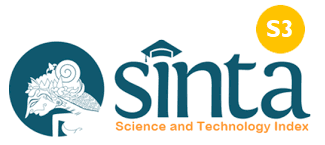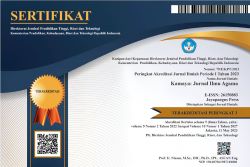Genealogy Story dalam Cerita Bidadari dari Indonesia Timur
(Toumatenden, Tomaseseq Ditingalor, Puteri Bungso, dan Punteri Pinto)
DOI:
https://doi.org/10.37329/kamaya.v8i2.3914Keywords:
Genealogy Story, Mythologis Angels Descending to Earth, Legitimation of AncestorsAbstract
Indonesia, with its diverse cultural heritage and rich history, has various mythologies and folktales featuring supernatural beings, including angels or celestial beings that come down to earth. The story of Angels who came down to earth found in various region in Indonesia, such as the story of Toumatenden (North Sulawesi), Tomaseseq Ditingalor (West Sulawesi), Putri Bungso (Ambon Island), and Punteri Pinto (Pantar Island). Apart from these four areas, the theme of angels descending to earth are also found in many regions of Indonesia, from Aceh to Papua. This research tries to explore the four angel stories from four regions in Eastern Indonesia. These four stories have a genealogy of ancestral origins that interwoven with the genealogy of ancestors of Minahasa, Mandar, Tehupelasurry, and Helang Dohi tribes in Pantar NTT. This Study uses descriptive qualitative method which requires field research. The result of this study has found that angel stories not only talk about angelic beings but also used as a tool to legitimize the identity and genealogy of ancestors who have special features. It shows a connection with the belief system in the celestial ‘samawi’ religion. The stories are also transformation from the story of ‘Adam and Eve’, the first humans or ancestors.
References
Asher-Greve, J. M., & Westenholz, J. G. (2013). Goddesses in Context: On Divine Powers, Roles, Relationships and Gender in Mesopotamian Textual and Visual Sources. Academic Press/Vandenhoeck & Ruprecht.
Black, J., & Green, A. (1992). Gods, Demons and Symbols of Ancient Mesopotamia: An Illustrated Dictionary. London: The British Museum Press.
Byrnes, G., & Coleborne, C. (2023). Critical Family History and Migration: Introductory Essay. Genealogy, 7(56).
Chandler, D. (2007). Semiotics: The Basics (2nd ed.). London: Routledge.
Davidoff, L., & Hall, C. (2018). Family Fortunes: Men and Women of the English Middle Class 1780–1850 (3rd ed.). London: Routledge.
Goody, J. (1968). Literacy in Traditional Societies. Cambridge: Cambridge University Press.
Greimas, A. J., & Courtes, J. (1982). Semiotics and Language: An Analytical Dictionary. Bloomington: Indiana University Press.
Henkelman, W. F. M. (2011). Šimut. Reallexikon der Assyriologie. Retrieved July 28, 2021.
Kelsey, W. M. (1981). Asian Folklore Studies, 40(2), 213–236.
Kramer, S. N. (1963). The Sumerians: Their History, Culture, and Character. Chicago, IL: University of Chicago Press. ISBN 978-0-226-45238-8.
McEvilley, T. (2002). The Shape of Ancient Thought: Comparative Studies in Greek and Indian Philosophies. New York, NY: Allworth Press. ISBN 978-1-58115-203-6.
Mills, G. (2003). Action Research: A Guide for the Teacher Researcher. New Jersey: Prentice Hall.
Nemet-Nejat, K. R. (1998). Daily Life in Ancient Mesopotamia. Santa Barbara, CA: Greenwood. ISBN 978-0-313-29497-6.
Routledge Evans, T. (2015). Fractured Families: Lives on the Margins in Colonial New South Wales. Sydney: UNSW Press.
Routledge Evans, T. (2021). How Do Family Historians Work with Memory? Journal of Family History, 46, 92–106.
Routledge Evans, T. (2022). Family History, Historical Consciousness and Citizenship: A New Social History. London: Bloomsbury Academic.
Sunarti, S. (2013). Kelisanan dan Keberaksaraan dalam Surat Kabar Terbitan Awal di Minangkabau (1859–1940-an). Jakarta: KGP.
Sweeney, A. (1987). A Full Hearing. Berkeley, CA: Center for South and Southeast Asia Studies, University of California.
Thompson, J. D. (1967). Organization in Action. New York: McGraw-Hill.
Vansina, J. (2014). Tradisi Lisan sebagai Sejarah. Yogyakarta: Ombak.
Wiradnyana, K. (2010). Legitimasi Kekuasaan pada Budaya Nias. Jakarta: Yayasan Obor Indonesia.
Downloads
Published
How to Cite
Issue
Section
License
Copyright (c) 2025 Kamaya: Jurnal Ilmu Agama

This work is licensed under a Creative Commons Attribution-ShareAlike 4.0 International License.
An author who publishes in the Kamaya : Jurnal Ilmu Agama agrees to the following terms:
- Author retains the copyright and grants the journal the right of first publication of the work simultaneously licensed under the Creative Commons Attribution-ShareAlike 4.0 License that allows others to share the work with an acknowledgement of the work's authorship and initial publication in this journal
- Author is able to enter into separate, additional contractual arrangements for the non-exclusive distribution of the journal's published version of the work (e.g., post it to an institutional repository or publish it in a book) with the acknowledgement of its initial publication in this journal.
- Author is permitted and encouraged to post his/her work online (e.g., in institutional repositories or on their website) prior to and during the submission process, as it can lead to productive exchanges, as well as earlier and greater citation of the published work (See The Effect of Open Access).
Read more about the Creative Commons Attribution-ShareAlike 4.0 Licence here: https://creativecommons.org/licenses/by-sa/4.0/.





